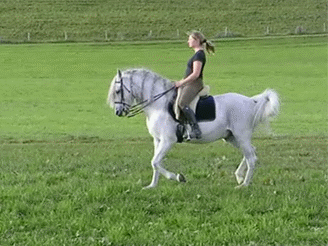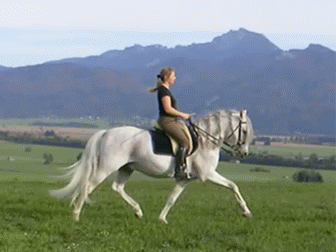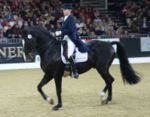
Passage (dressage)
Encyclopedia

Dressage
Dressage is a competitive equestrian sport, defined by the International Equestrian Federation as "the highest expression of horse training." Competitions are held at all levels from amateur to the World Equestrian Games...
, in which the horse performs a highly elevated and extremely powerful trot
Trot (horse gait)
The trot is a two-beat diagonal gait of the horse, where the diagonal pairs of legs move forward at the same time. There is a moment of suspension between each beat....
. The horse is very collected
Collection (horse)
Collection is when a horse carries more weight on his hindlegs than his front legs. The horse draws the body in upon itself so that it becomes like a giant spring whose stored energy can be reclaimed for fighting or running from a predator...
and moves with great impulsion
Impulsion
Impulsion is the pushing power of a horse, which comes from its desire to move powerfully forward with energy. However, speed does not create impulsion, and a rushing horse is more likely to be "flat" than impulsive...
.

Trot (horse gait)
The trot is a two-beat diagonal gait of the horse, where the diagonal pairs of legs move forward at the same time. There is a moment of suspension between each beat....
in that the horse raises a diagonal pair high off the ground and suspends the leg for a longer period than seen in the other trot types. The hindquarters are very engaged, and the knees and hocks are flexed more than the other trot types. The horse appears to trot in slow motion, making it look as if it is dancing. The passage is first introduced in the dressage intermediaire test II. A horse must be well-confirmed in its training to perform the passage, and must be proficient in collecting while remaining energetic, calm, and supple. The horse must also have built up the correct muscles to do the strenuous movement.
External links


